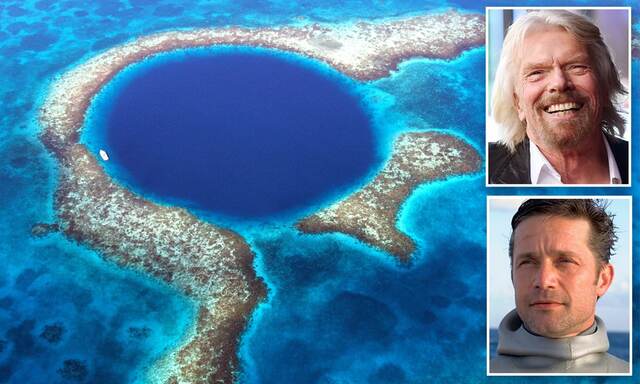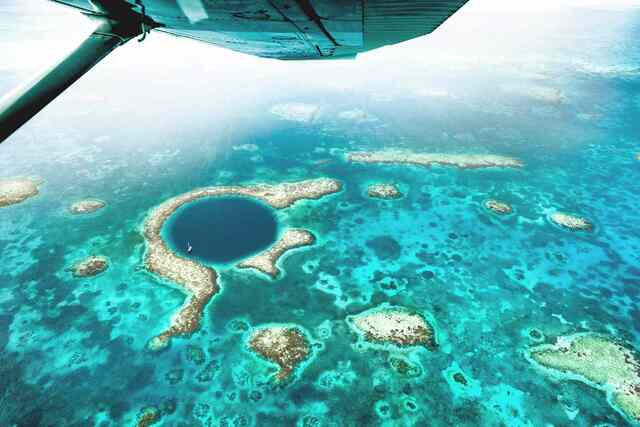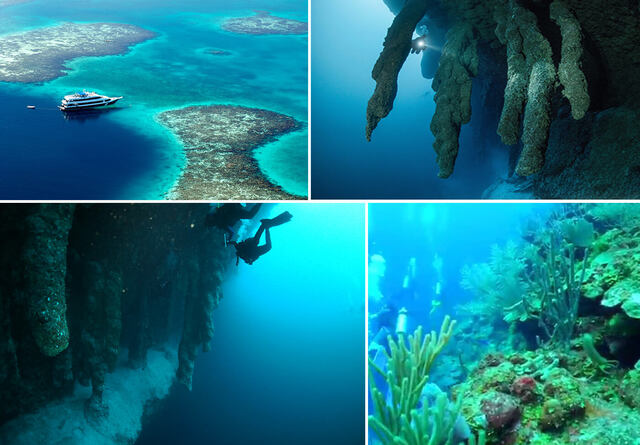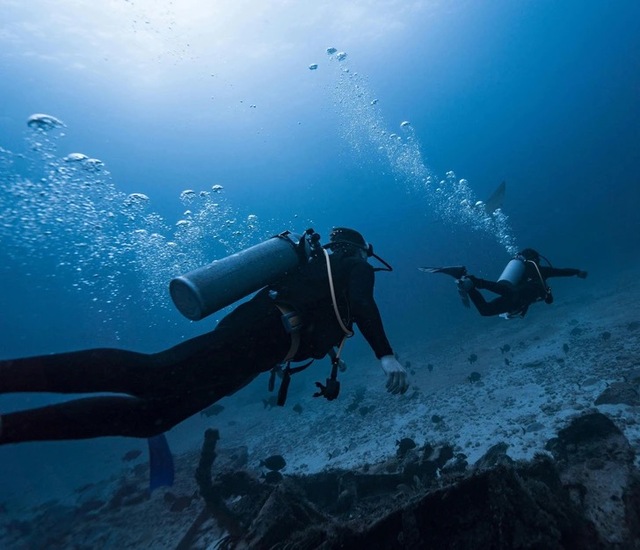Located in the heart of the Caribbean, off the coast of Belize, lies a magnificent and eerie natural wonder known as the Great Blue Hole. This giant underwater sinkhole, spanning over 1,000 feet in diameter and plunging 407 feet into the ocean, has been a source of fascination and mystery for scientists, divers, and explorers alike. From its discovery to the thrilling expeditions that revealed its hidden depths, the Great Blue Hole holds secrets of Earth’s past, offers clues about our planet’s future, and serves as a powerful reminder of our environmental impact.
The Enigma of the Great Blue Hole
The Great Blue Hole is not just a geological marvel but also a captivating symbol of the unknown. From space, it appears as a giant sapphire nestled in the turquoise waters of the Caribbean. For centuries, this underwater abyss remained a hidden mystery, its true depths unknown to the world. It wasn’t until 1971 when legendary explorer Jacques Cousteau declared it one of the top diving destinations that the Great Blue Hole became a focal point for ocean exploration. Since then, this enigmatic sinkhole has drawn adventurers and scientists eager to uncover its secrets.
Despite its recognition, the Great Blue Hole’s depths remained largely unexplored for decades, with only a handful of dives conducted before technology advanced enough to provide a clearer understanding of what lay beneath. With modern submarines and cutting-edge technology, scientists have now begun to unlock the mysteries of this underwater world, revealing startling and fascinating discoveries that were once beyond our reach.

Dive deeper into the mysteries of the Great Blue Hole with Monty Halls as he uncovers the secrets and dangers lurking beneath the surface. Watch this documentary to experience the thrill of exploration and the eerie allure of this underwater marvel.
How the World Discovered This Ocean Abyss
For centuries, the Great Blue Hole was known only to the locals of Belize. The Lighthouse Reef, where it resides, was a quiet, unexplored region—until Jacques Cousteau’s iconic visit in 1971. His team conducted a series of dives and documented their findings, putting the Blue Hole on the global map. Cousteau’s exploration sparked widespread curiosity about the sinkhole, and soon after, divers from around the world were eager to experience it firsthand.
However, despite Cousteau’s efforts, much of the Blue Hole’s true nature remained a mystery. It took decades of technological advancements to finally get a complete picture of the ecosystem and geology of this underwater world. Only in recent years, with the help of modern submarines and deep-sea exploration technology, have scientists been able to fully dive into the depths and discover what lies at the bottom of this massive abyss.
The 2018 Expedition That Unlocked Its Secrets
In 2018, a new chapter in the exploration of the Great Blue Hole was written when Fabien Cousteau, grandson of Jacques Cousteau, partnered with entrepreneur Richard Branson for a groundbreaking expedition. Using state-of-the-art submarines, their team ventured into the depths of the Blue Hole, capturing a firsthand look at its mysterious waters.
The first 100 feet of their descent revealed a vibrant and thriving underwater ecosystem. Coral reefs teemed with colorful fish, and reef sharks glided gracefully through the crystal-clear water. This portion of the Blue Hole was teeming with life, offering a stunning contrast to what awaited below. As the team descended further, from 100 to 300 feet, the light began to fade, and the water turned a haunting midnight blue.

At depths beyond 300 feet, a thick layer of hydrogen sulfide created a toxic, oxygen-free barrier that shrouded the explorers in complete darkness. Below this layer, life as we know it could not survive, and what they found was a stark reminder of the fragility of life at extreme depths. The journey into this darkness unlocked some of the Blue Hole’s greatest mysteries but also posed new questions about the future of such pristine ecosystems.
Join a daring diver as they explore the depths of the Great Blue Hole at 390 feet! Discover the astonishing secrets that lie at the bottom of this mysterious underwater world—what they find will leave you in awe.
Human Impact at the Bottom of the Abyss

Even in this seemingly untouched corner of the planet, the team’s discovery of human-made waste was a sobering reminder of the global reach of pollution. Amidst the breathtaking beauty of the Blue Hole’s depths, a lone plastic bottle and a discarded GoPro camera were found. These artifacts serve as a stark reminder that no part of the Earth, no matter how remote or seemingly pristine, is immune to human impact.
The pollution discovered at the bottom of the Blue Hole highlights the far-reaching consequences of our waste and serves as a warning about the importance of protecting even the most isolated and untouched environments. It is a testament to the fact that our actions, no matter how far removed, are affecting the planet in ways that are hard to undo.
A Tragic Reminder of Diving Risks
While the Blue Hole is renowned for its natural beauty, it also has a darker side. The strong currents, unpredictable tides, and disorienting darkness make it a notoriously dangerous dive site. Over the years, several divers have tragically gone missing, and their remains were discovered by the 2018 expedition team. The team chose to leave these remains undisturbed, out of respect for the lives lost, but the discovery served as a haunting reminder of the extreme risks that come with deep diving.
The Great Blue Hole is not just a wonder of nature—it’s also a reminder of the dangers that lurk beneath the surface. For those who choose to dive into its depths, the risks are high, and the challenges are immense. The tragic stories of lost divers serve as a cautionary tale about the perils of venturing into such an unforgiving and mysterious environment.

Ancient Clues Hidden in Stalactites
Beyond the human discoveries, the 2018 expedition also uncovered geological evidence that rewrote much of what scientists thought they knew about the Blue Hole. Stalactites—large formations typically found in dry caves—were found deep beneath the water’s surface. Their presence in the Blue Hole suggests that, millions of years ago, the sinkhole was once above sea level.
Scientists estimate that the Great Blue Hole was formed over 10,000 years ago during the last Ice Age when sea levels were much lower. As the Ice Age ended and the ice sheets melted, rising sea levels engulfed the cave system, leaving behind the massive sinkhole we see today. These ancient clues offer an invaluable glimpse into the planet’s geological history and provide scientists with key insights into the effects of climate change on Earth’s natural formations.

A Warning About Climate Change
As Richard Branson remarked during the 2018 expedition, the Great Blue Hole serves as a “stark warning” about the rapid changes our planet is undergoing. The visible marks on the walls of the Blue Hole show where land once stood before it was swallowed by the sea. With global temperatures rising and ice caps melting, experts predict that sea levels could rise dramatically in the coming decades, threatening coastal cities and fragile ecosystems worldwide.
The Blue Hole is not just a geological phenomenon; it’s a symbol of how quickly our planet is changing. The rapid rise in sea levels is reshaping coastlines and threatening biodiversity, and the Blue Hole serves as a powerful reminder of the urgency with which we must address climate change.

Why the Great Blue Hole Still Draws the Brave
Despite its dangers, the Great Blue Hole remains a magnet for explorers, scientists, and divers alike. Its beauty, scientific significance, and the ultimate diving challenge it presents continue to attract adventurers from around the world.
From above, the contrast between the deep sapphire of the Blue Hole and the surrounding turquoise reef is breathtaking. Below the surface, the Blue Hole offers a living record of the planet’s geological and climatic history, making it an invaluable resource for scientists studying Earth’s past. For divers, it represents a once-in-a-lifetime adventure—a thrilling, and often perilous, opportunity to explore one of the world’s most iconic underwater locations.
Take the plunge into one of the world’s most stunning underwater wonders. Watch this video to explore Belize’s jaw-dropping Blue Hole and experience the breathtaking beauty and mystery that lies beneath its surface.
Conclusion: A Living Museum and a Wake-Up Call
The Great Blue Hole is not just an extraordinary natural wonder—it is a powerful reminder of our planet’s fragility. From its ancient geological formations to its hauntingly dark depths, the Blue Hole offers clues about our Earth’s past and warnings about its future. As explorers continue to uncover its secrets, one message is clear: We must take steps to preserve and protect such wonders, ensuring that future generations can continue to marvel at the mysteries hidden beneath Belize’s brilliant blue waters.


